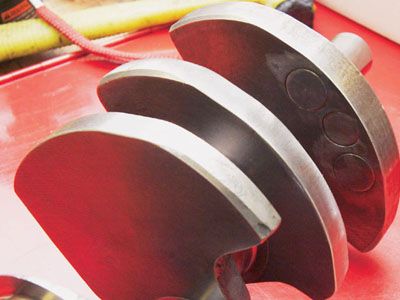
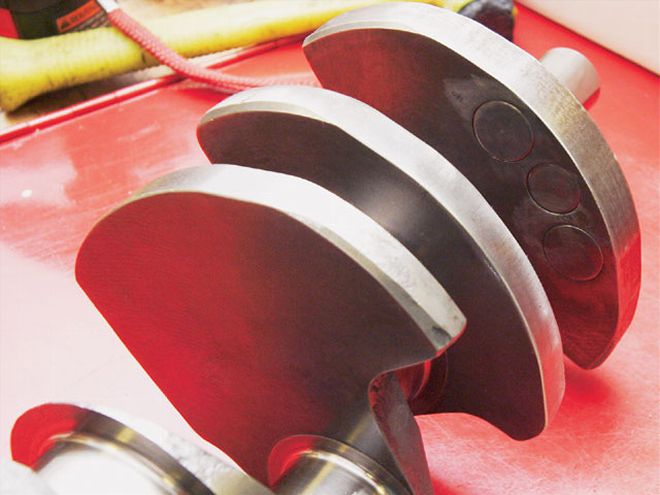 Most race crankshaft manufacturers prefer to balance with a smooth outside diameter. This means no holes drilled into the outside edge of the counterweights. Holes only increase windage. The solution is to turn the counterweights down to a minimum diameter and then add slugs of heavy metal to bring the crank into balance. In this photo, you can see three slugs of heavy "mallory" metal in the far counterweight.
Most race crankshaft manufacturers prefer to balance with a smooth outside diameter. This means no holes drilled into the outside edge of the counterweights. Holes only increase windage. The solution is to turn the counterweights down to a minimum diameter and then add slugs of heavy metal to bring the crank into balance. In this photo, you can see three slugs of heavy "mallory" metal in the far counterweight.
The crankshaft is, by far, the most massive moving part in your race engine. There's a reason for that-the crankshaft is essentially ground zero for every bit of the torque your high-buck race engine is capable of producing. It's eight pistons connected to connecting rods, which in turn are connected to the crankshaft, pounding down intermittently with incredible force. Meanwhile, at the back, the crank is connected to the clutch-and eventually the rear wheels-which is trying to resist acceleration. The same thing is going on at the front where the water pump, alternator, and other power-robbing assemblies are providing resistance
The result is a multitude of twisting forces applied to the crankshaft the entire time the engine is running. The stresses are multiplied in a racing situation in which the rpm levels can get quite extreme, and the frequent transitions from wide-open throttle to zero throttle only add to the equation.
Fortunately, these thoughts are nothing new to racing engine builders or the companies that supply them with aftermarket crankshafts. Because of its expense and the trouble involved when one breaks, racers require the crankshaft to be dependable-virtually bulletproof. But because excess weight limits maximum rpm, the lightest crankshaft possible is also desirable. This means that a stock, cast crank is suitable only for the most entry-level, cost-conscious levels of racing.
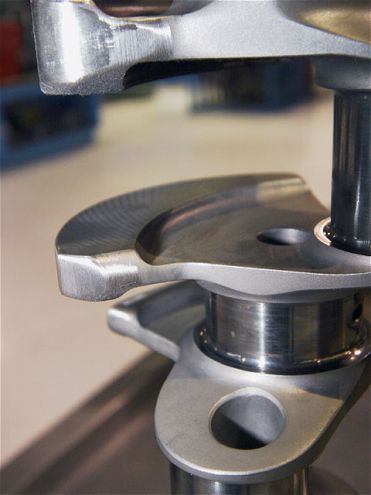 Here's another look at pendulum-cut counterweights. This design puts most of the counterweight's mass at the outer edge, which helps it mirror the center of mass of a piston on a long rod while still lowering the crank's overall weight.
Here's another look at pendulum-cut counterweights. This design puts most of the counterweight's mass at the outer edge, which helps it mirror the center of mass of a piston on a long rod while still lowering the crank's overall weight.
Forged vs. Billet
Crankshafts that are purpose-built for oval track racing are almost exclusively either forged or constructed from a piece of billet steel. Both offer supplemental strength over cast pieces in addition to other advantages. Forged pieces are relatively inexpensive. Forgings produce a stronger grain structure and, if fully machined, can be exceptionally strong. Advancing CNC technology allows for billet crankshafts with extreme precision. A solid piece of steel means great continuity and allows a more consistent heat treat after the cutting is complete. Also, because each crank is cut individually, a piece with really unique specs can often be cut from billet more cheaply than forged.
Either way, a quality crankshaft that's either forged or billet is ideal for medium- to high-horsepower racing engines. Ultrahigh-horsepower engines usually use billet pieces, but one engine builder told us that for medium-horsepower engines, his decision between forged and billet cranks usually comes down to availability.
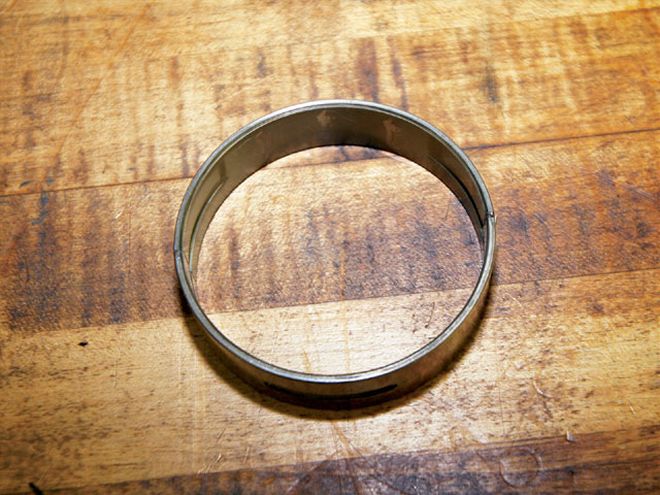 Rick King of King's Crankshafts recommends a main bearing with a 31/44 oil groove. This means the oil groove covers 31/44 of the inside of the bearing, or 270 degrees. This provides better oiling to the crankshaft's main journals.
Rick King of King's Crankshafts recommends a main bearing with a 31/44 oil groove. This means the oil groove covers 31/44 of the inside of the bearing, or 270 degrees. This provides better oiling to the crankshaft's main journals.
The Crankshaft Diet OEM
Crankshafts are designed to last well over 100,000 miles and to operate for extended periods at low rpm levels. While the big three might be hesitant to admit it for certain models, maximum acceleration is actually pretty low on the priority list.
For racing, however, acceleration is paramount, and every extra pound of crankshaft the engine has to spin is just that much more power that's robbed from the rear wheels. First, the crank can be gun-drilled, which is essentially hollowing out all the main journals. Rick King, owner of King's Crankshafts, says this can cut as much as 3 pounds out of the crank, but because it's in the very center of the rotation, the gain is minimal. The same thing can be done to the rod journals, which will shave a couple of additional pounds
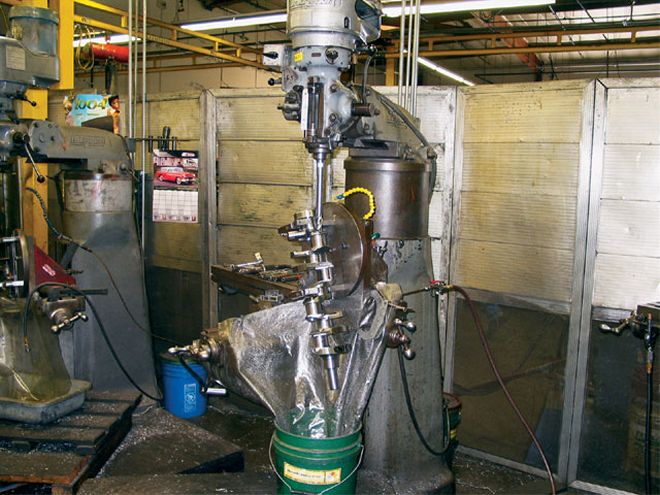
The best places to remove weight are on the outside edges of the crank. In order to keep the entire crank/connecting rod/piston assembly from vibrating itself-and the engine-apart, the crankshaft has counterweights designed to balance out the moving mass of the rods and pistons. Cutting the combined weight of the piston, rod, wristpin, and rings (commonly referred to as the bob weight) means you can also make a corresponding reduction in the size of the crank's counterweights. Interestingly, not only is the amount of metal in the counterweight important, but its location in terms of distance from the crank centerline is also critical to provide proper balance. Basically, a longer connecting rod moves the center of balance of the rod/piston combination farther away from the crank centerline, so the center of mass of the counterweight should be moved outboard, too.
"In a perfect world, you would want to have the maximum amount of material as far out as you could get it so that the crank would still fit in the engine block," explains Peter Lieb, the manufacturing manager for Scat Crankshafts. "That's generally the best-case scenario for balancing the crank. Now, what happens when you go with a shorter rod? You have to cut the crankshaft so that it takes material off of the bottom of the counterweight. You have to move the weight toward the pin (the rod end of the crankshaft), which makes it not balance as well."
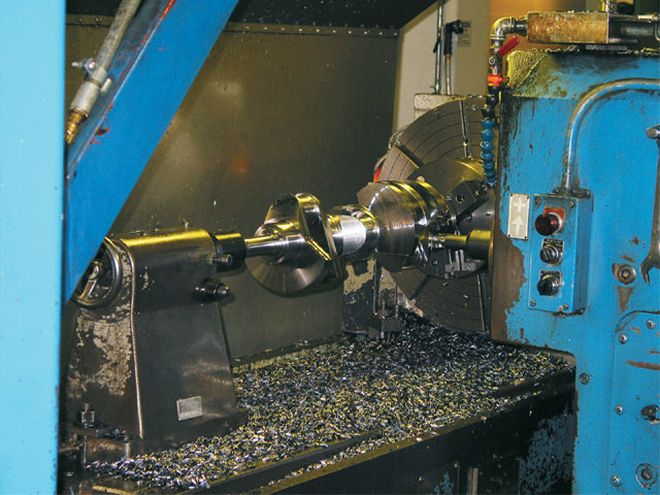
The advantage is that a long rod is a good match for a pendulum (or undercut) counterweight. On a pendulum counterweight, the majority of the mass is hung on the outside edge of the counterweight, allowing an overall lighter crank that will still balance against the inertial forces of the moving rod and piston.
King recommends using a pendulum-cut crank on applications up to about 600 horsepower. "After that," he says, "you start to get a little too much flexing in there because of the power."
Small Journals Like weight, the journal sizes originally set by the manufacturer might not be the best choice for racing. For a Chevrolet 350, the traditional rod journal size is 2.1 inches. Engine builders have found there are numerous advantages of a smaller journal size, the most significant being that it slows the bearing speed.
For example, imagine a fixed point on the outside circumference of the crankshaft's rod journal. While the crank spins, that point on the rod journal will turn while the rod bearing surrounding it essentially remains still. This means that during one full revolution of the crank, that spot on the rod journal will make a complete revolution around the inside of the bearing. Even if the rpm level of the engine is the same, if the journal size is larger, the speed of the movement between the journal and the bearing is greater. Conversely, smaller equals slower. Even though a thin film of lubricant separates the journal and the bearing, a greater bearing speed still equals increased friction.
By reducing the size of the rod journal, you can essentially reduce the friction created. That is why many racing cranks for the Chevy 350 use the 2-inch 327 journal size. This is possible because there are still plenty of rod options available. Nextel Cup teams use a 1.888-inch journal (commonly called a Honda journal) for an even greater reduction in friction. The problem is the availability of connecting rods. Honda bearings are available for the size, but racing rods must be specially made. While the Honda journal is becoming more common in racing, the rods are still hard to come by.
After the grinding is completed, the crankshaft goes through several steps before it makes its way out of the plant. The lightening holes are bored into the crankshaft, which then moves to its machining step. From there, the oiling holes become a part of the finished product. The crankshaft is then packaged and ready to be shipped.">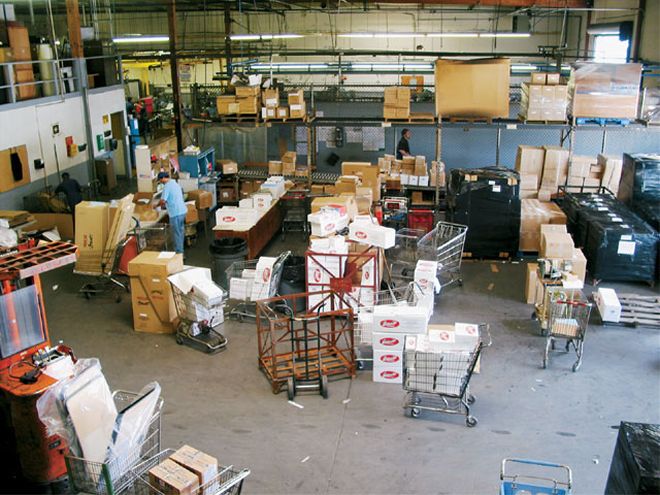 The Crankshaft Process<br>After the grinding is completed, the crankshaft goes through several steps before it makes its way out of the plant. The lightening holes are bored into the crankshaft, which then moves to its machining step. From there, the oiling holes become a part of the finished product. The crankshaft is then packaged and ready to be shipped.
The Crankshaft Process<br>After the grinding is completed, the crankshaft goes through several steps before it makes its way out of the plant. The lightening holes are bored into the crankshaft, which then moves to its machining step. From there, the oiling holes become a part of the finished product. The crankshaft is then packaged and ready to be shipped.
Bob Koch, owner of Race Engineering, says that in addition to the reduced friction, smaller journals also have another advantage. "Not only do you get less bearing speed, you are reducing your weights," he says. "The reduction on the crank side is obvious, but it's also minimal. It's the reduction in the rod weight that can be important. If the rod manufacturer does the job properly when they make rods with smaller journals, they will move the bolt locations inboard. Then, they can machine some of the steel off from around the pads where the bolts go, which gets rid of weight."
Even though this reduction in weight can amount to just a handful of grams, you have to consider the location. Because it is away from the crank centerline, this weight is critical. Plus, removing it also reduces the bob weight, allowing the counterweights to be smaller, too.
Smaller main journals also offer the same benefits for lowering the bearing speed. The problem is most of us cannot simply order a custom engine block, and most are made with standard main journal sizes. As a fix for this, Race Engineering offers bearing spacers which allow a small-journal crank to work in a large-journal block. The spacer looks a lot like a bearing that another bearing will fit into.
"A lot of guys will tell you that's not the smart way to do it, and they are probably right," Koch says. "You really don't want to throw another piece of steel into the engine [if you don't have to]. But if you have a large-journal block and want to go with a smaller journal crank, this will let you do it-and it works. You just have to watch your clearances like you would with any engine build."
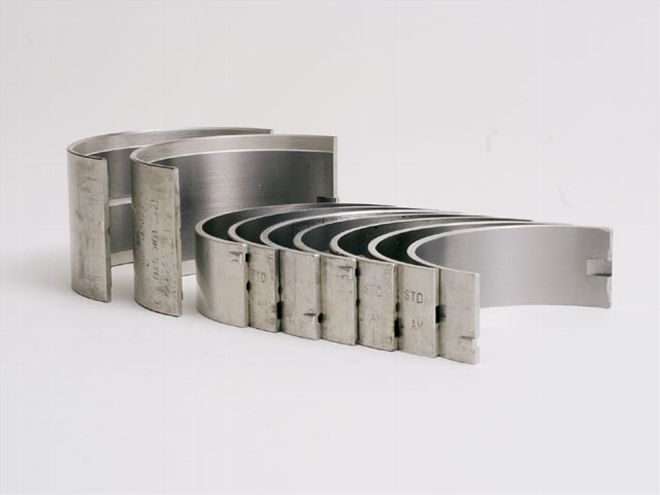 For situations where you may want to use a crankshaft with small main journals in a block with larger journals, Race Engineering offers bearing spacers. They look a lot like bearings but are designed to sandwich in between the block and the smaller bearings.
For situations where you may want to use a crankshaft with small main journals in a block with larger journals, Race Engineering offers bearing spacers. They look a lot like bearings but are designed to sandwich in between the block and the smaller bearings.
Windage Simply put, windage is the power loss caused by oil splashing against or clinging to the crankshaft as it spins. Windage is a concern in any race engine, but it's especially important to try to minimize it in a wet sump engine. Good oil control begins with a quality oil pan and scraper, but crank design can also help. Racing cranks generally feature narrower counterweights and, when rules allow, a shaped leading edge on the counterweight. Instead of a flat edge splashing into oil, a curved leading edge helps reduce the impact of crank against oil. Interestingly, representatives from both King's Crankshafts and Scat both stated during our interviews that they do not recommend knife-edging the leading edge. Instead, they prefer a rounded leading edge (also called a bullnose).
"The knife-edging takes a lot of weight out of the leading edge of the counterweights, which will make the crank more difficult to balance," King explains. "Plus, depending on how much material you remove to create the knife edge, the bearings also won't wear as well."
Expert Advice
One of the greatest challenges we face when guys build their own engines is getting them to understand that snap gauges just do not work. That is one of the first things we ask when a guy calls us and tells us it got too hot on one of the mains. To everyone planning to build their own engines, I recommend spending a little money on a dial bore gauge. Then, they know they can do all the clearances correctly.-Rick King, King's Crankshafts
Expert Advice
One interesting thing that the Nextel Cup guys have learned recently is that at high-rpm levels, overbalancing can cause problems. It's common to overbalance, or add balance weight to the counter weights, at 51 or 52 percent. What we didn't realize is that as rpm goes up, those counterweights get heavier and heavier through centrifugal force.
So, the Cup guys, once they went from 8,500 to 9,000-and even 9,200 rpm-started scuffing bearings. And they couldn't figure out why. Evidently, one guy said, "Let's try something different. Let's cut the counterweights off." I'm using that very loosely, but what they did was turn the counterweights down and then add heavy metal to get the mass back up. All of a sudden, the problem started to go away.
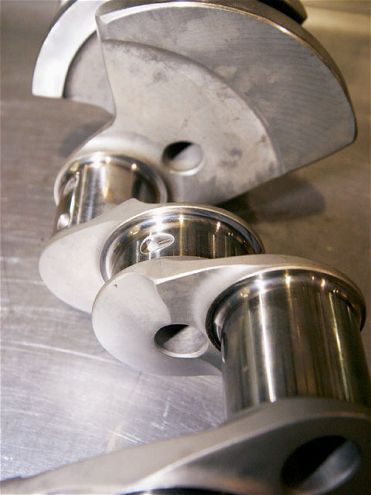 Lightening holes through the crank journals can shave at least 3 pounds of excess weight off the crank.
Lightening holes through the crank journals can shave at least 3 pounds of excess weight off the crank.
And then someone came up with the idea to underbalance, and that helped even more. I would venture to say that most of the cars on the starting line for the next open-motor race will be underbalanced-some by as much as 45 percent. -Peter Lieb, Scat Crankshafts
Expert Advice
With the V-8 motors, we never recommend a cast crankshaft, but that is something we've found you can get by with on the four-cylinder motors. From what I understand, they have a little more flex in them, so they seem to be able to take a pounding. They may not have the life cycle of a forged crank, but they are still pretty good.
The ARCA Truck motor we did is a pretty good example. We offset-ground it down to a Honda journal and increased the stroke by 0.04 inch. Now, this is a dry sump motor, and we really wind them up. We won that series two years running using a cast crank, and we've never had a failure issue with it.
We are also in the midst of testing to see just how much we can stroke a Ford 2.3 engine. We've got a highly modified crank out of another engine that we're trying. It's a factory steel crank, and we are looking to get somewhere in the range of 3.67 inches of stroke. That should result in about 2,800 cc from the 2.3-liter block. That much stroke will really help with the torque, which is what you are always trying to find in four-cylinder race motors.-Bob Koch, Race Engineering